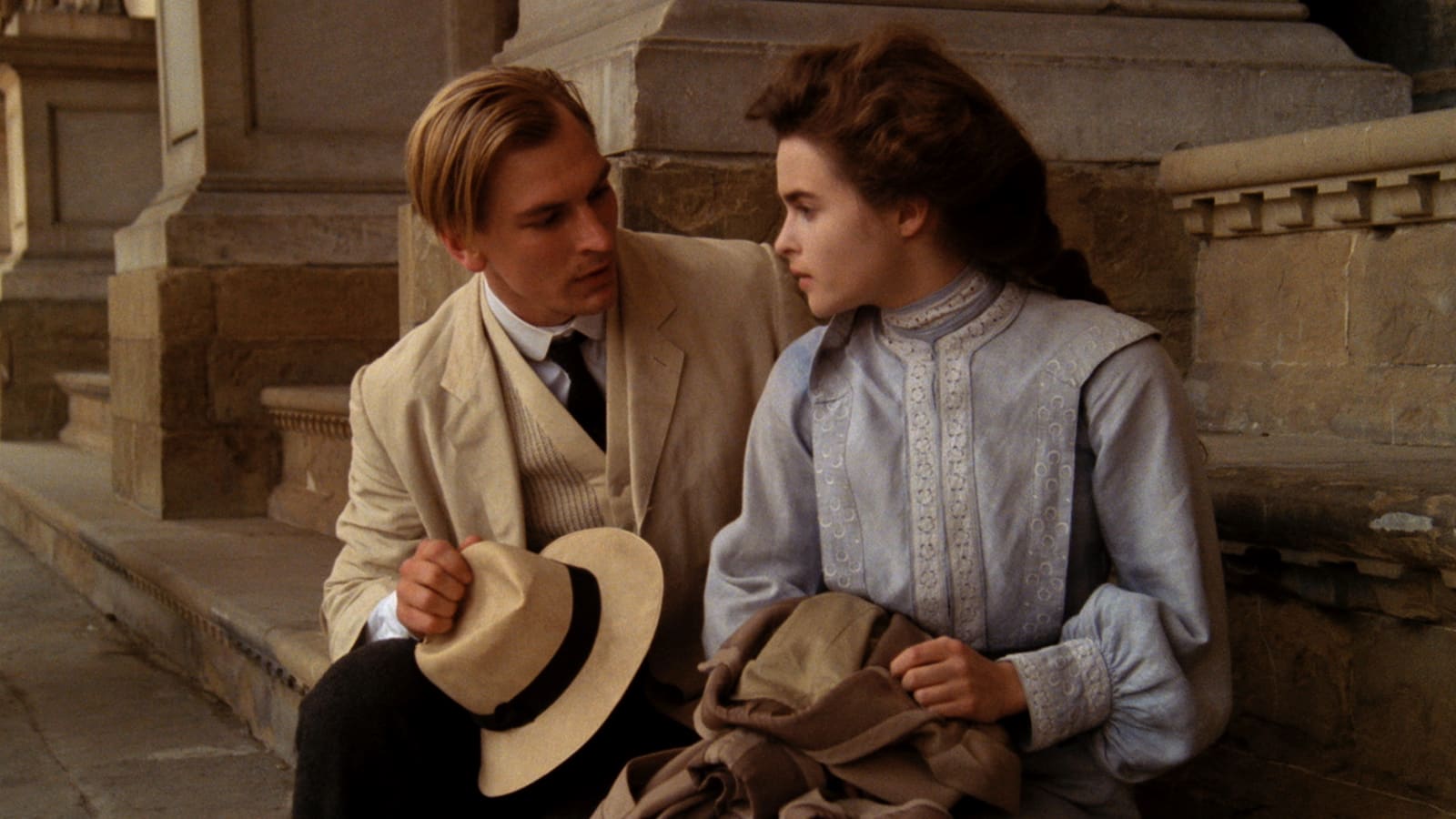Looking back on the career of Julian Sands, whose remains were just found and identified after he went missing back in January while hiking in California’s San Gabriel Mountains, can be a bit of a puzzling experience. There was a time early on when it seemed as if he was poised to become as big and celebrated of a performer as his one-time co-star Daniel Day-Lewis, and throughout his career, he would indeed work with a number of highly respected filmmakers. On the other hand, he seemed at times to almost be going out of his way to avoid the stardom that seemed so imminent by choosing bizarre-looking projects. And yet, no matter how dubious some of these enterprises might have seemed, you never got the sense that he was just coasting his way through junk in exchange for a quick paycheck—he was always clearly focused on whatever it was that he was doing, and, even when the project as a whole was less than impressive, he always helped to make them work for as long as he was on the screen.
He was born in Yorkshire, England on January 4, 1958, and studied acting at the Royal Central School of Speech and Drama in London. He began appearing on the stage and television, making his screen debut in 1983 in the odd post-WWII comedy-drama “Privates on Parade.” The next year saw him appear in a television adaptation of Ernest Hemingway’s “The Sun Also Rises” and as the roommate and teammate of American hustler-turned-Oxford rowing champion Rob Lowe in “Oxford Blues.” Later that year, he turned up in a better project when he portrayed British journalist Jon Swain in the highly acclaimed drama “The Killing Fields.” In 1985, he made his first excursions into the horror genre that he would return to time and again—first in the perplexing psycho-thriller “After Darkness” and then in “The Doctor and the Devils,” a prestigious project inspired by the infamous case of Burke & Hare and based upon a screenplay written by no less a figure than Dylan Thomas.
Outside of “The Killing Fields,” none of those films made much of an impact but that was not the case with his next film, the Merchant-Ivory adaptation of E.M. Forster’s “A Room with a View,” in which he played George Emerson, the free-spirited young man who charms the repressed Lucy Honeychurch (Helena Bonham Carter) during a brief shared idyll in Tuscany to such a degree that she finds it difficult to return to her proper life and priggish fiancée (Day-Lewis). Perhaps the most sheerly entertaining of all the Merchant-Ivory collaborations, the film would go on to become an unexpected hit around the world—running for a year or so in some theaters—and would go on to win three Oscars (out of eight nominations), five BAFTAs and a Golden Globe, as well as making international stars out of then-unknowns Carter, Day-Lewis and Sands. Of the three, it was Sands who had perhaps the greatest impact on viewers, who found themselves practically swooning every time he turned up to woo Lucy, not to mention the memorable moment in which he was seen skinny-dipping in a pond.
Thanks to his presence in both “The Killing Fields” and “A Room with a View,” Sands was clearly on the verge of stardom. With his next major role, he went in a decidedly different direction by turning up as Percy Shelley in “Gothic” (1986), Ken Russell’s hair-raising, if factually questionable, take on that infamous meeting of the minds between Shelley, his wife Mary (Natasha Richardson), John Polidori (Timothy Spall) and Lord Byron (Gabriel Byrne) that led to Mary Shelley writing Frankenstein. Like most Russell films, this was less a coherent narrative than an excuse for Russell to indulge in bizarro shock effects and in-jokes—not that there is anything wrong with that in this particular case—and Sands does a good job of bridging the gap between the staid period piece some might have expected and the wild cult eccentricity that it proved to be. To prove that this particular choice was no fluke or whim, Sands would move on to an even loopier project with “Siesta,” Mary Lambert’s strange 1987 erotic fantasia in which he plays one of the many oddball characters encountered by daredevil Ellen Barkin in the days leading up to a potentially fatal stunt.
In 1988, he turned up in “Vibes,” a troubled and mostly inexplicable action-comedy-fantasy that attempted to translate Cyndi Lauper’s enormous success on the record charts to the multiplex and missed the mark so completely that you may have forgotten that this film even existed until you began reading the sentence. He had somewhat better luck in a supporting turn in “Arachnophobia,” in which he played the entomologist charged with explaining all the science-type stuff to the other characters (and the audience) regarding the deadly spiders invading a small town before meeting an icky demise—although not a box-office hit, the so-called “thrillomedy” would gain a loyal cult following over the years. This would also be the case with “Warlock,” a silly horror film in which he played the title role—although produced in 1989, it would not be released until 1991 and it would prove to be successful enough to inspire “Warlock: The Armageddon,” a 1993 continuation that shared no connection with its predecessor save for Sands.
1991 would also see Sands returning to more prestigious fare, albeit with a twist in one case. In James Lapine’s “Impromptu,” he played composer Franz Liszt in a period piece exploring the romantic pursuit of Frederic Chopin (Hugh Grant) by writer George Sand (Judy Davis)—both he and the film are intriguing and charming enough but perhaps of most interest to those who wonder what those aforementioned Ken Russell fantasy biopics might have looked like without Russell in charge. He made a far more memorable impression on viewers with his appearance in David Cronenberg’s mind-melting adaptation of William Burroughs’ “Naked Lunch,” where he played Yves Cloquet, a character who at first appears to be a suave, charming and gay Swiss man but is eventually proven to be a grotesque giant centipede creature posing in human form. In hindsight, this could well be the ultimate Sands character—handsome and urbane on the outside, twisted beyond belief on the inside, and utterly compelling either way.
If Cloquet is the quintessential Sands character, I would argue that his next major project is the quintessential Sands film. That would be “Boxing Helena,” the controversial debut film from Jennifer Lynch in which he plays Nick Cavanaugh, a brilliant but socially maladjusted surgeon whose intense obsession with Helena (Sherilyn Fenn), a woman that he had a one-night stand with that changed his life but made zero impression on her, leads him to hold her captive in his remote mansion, ostensibly to care for her in the wake of a terrible auto accident, and amputate her limbs to keep her from escaping. Yes, the premise is icky and that, combined with the notorious issues surrounding the film’s production (both Madonna and Kim Basinger were set to star before backing out with the latter being successfully sued by the producers) ensured that it flopped when it came out in 1993.
And yet, while the film continues to have a fairly terrible reputation, it is actually quite good (as a recent viewing of a rare 35mm screening last year confirmed) and a lot of the reason that the film works is because of Sands. Yes, there is the undeniable sex appeal of Fenn, the cheerful goofiness of supporting player Bill Paxton and the weirdo imagery conjured up by Lynch. However, this is a film that embodies any number of tones throughout—at various points, it works as dark comedy, earnest drama, twisted romance, bizarro fairy tale and dreamy erotica—and Sands rolls with the punches throughout all those shifts. Sure, his character is a bit of a creep but damned if he doesn’t make the character work so that you still find yourself sympathizing with him in spite of his misdeeds. It is a wonderful and surprisingly effective performance and if this article inspires you to seek out any of Sands’ films that you may not have seen before, “Boxing Helena” should be at the top of your list.
“Boxing Helena” would turn out to be one of his last starring roles in a major theatrical film, but he would continue to work steadily, often in conjunction with filmmakers who also preferred to work outside of the margins of contemporary cinema. He was a frequent collaborator with Mike Figgis, beginning with “Leaving Las Vegas” (1995) and including “One Night Stand” (1997), “The Loss of Sexual Innocence” (1999), “Timecode” (2000), “Hotel” (2001) and “Suspension of Disbelief” (2012). He played another evil warlock in Paul Schrader’s weird fantasy-noir hybrid “Witch Hunt” (1994) and essayed the title role in Dario Argento’s super-gory take on “The Phantom of the Opera” (1998) opposite Asia Argento. He reunited with “The Killing Fields” director Roland Joffe on the period drama “Vatel” (2000) and turned up as part of the decidedly eclectic cast in Wim Wenders’ “The Million Dollar Hotel” (2000). He popped up amidst the equally huge cast in Steven Soderbergh’s “Ocean’s Thirteen” (2007) and played the younger version of Christopher Plummer’s character in David Fincher’s version of “The Girl with the Dragon Tattoo” (2011). In the grueling war drama “The Painted Bird” (2019), he plays a pedophile who takes in the young boy at the center of the story and meets a gruesome end. He also turned up in a small role as a medical officer in “Benediction,” Terrence Davies’ 2021 biopic of poet Siegfried Sassoon.
During this time, Sands also became a familiar face (and voice) of television as well. He was one of the stars of the 2002 Stephen King miniseries “Rose Red” and did one of the voices of the popular animated series “Jackie Chan Adventures” (and would appear opposite Chan in the flesh in the 2003 adventure “The Medallion”). He was one of the bad guys in the fifth (and arguably best) season of “24,” turned up in a couple of episodes of “Smallville” as none other than Superman’s fathers Jor-El and appeared on such other shows as “Law & Order,” “Dexter,” “Banshee,” “Gotham” and “The Blacklist.” As a voice actor, he appeared in the popular video games “Star Wars: The Old Republic” and “Call of Duty: Black Ops II” and portrayed Q in a series of adaptations of the James Bond novels done for BBC radio.
Maybe the reason he never quite broke through in the way the people may have expected in the wake of “A Room with a View” is because he was a bit of a conundrum—a guy with matinee idol looks and the heart of a character actor—that the industry could never quite get a handle on. And yet, even when the projects were on the dire side (and I have left out a lot of those in this piece), he almost always came through with compelling and committed performances. His cinematic legacy may indeed be a bit of the weird side but there are plenty of treasures—both well-known and unsung—for future generations of moviegoers to discover for themselves.












